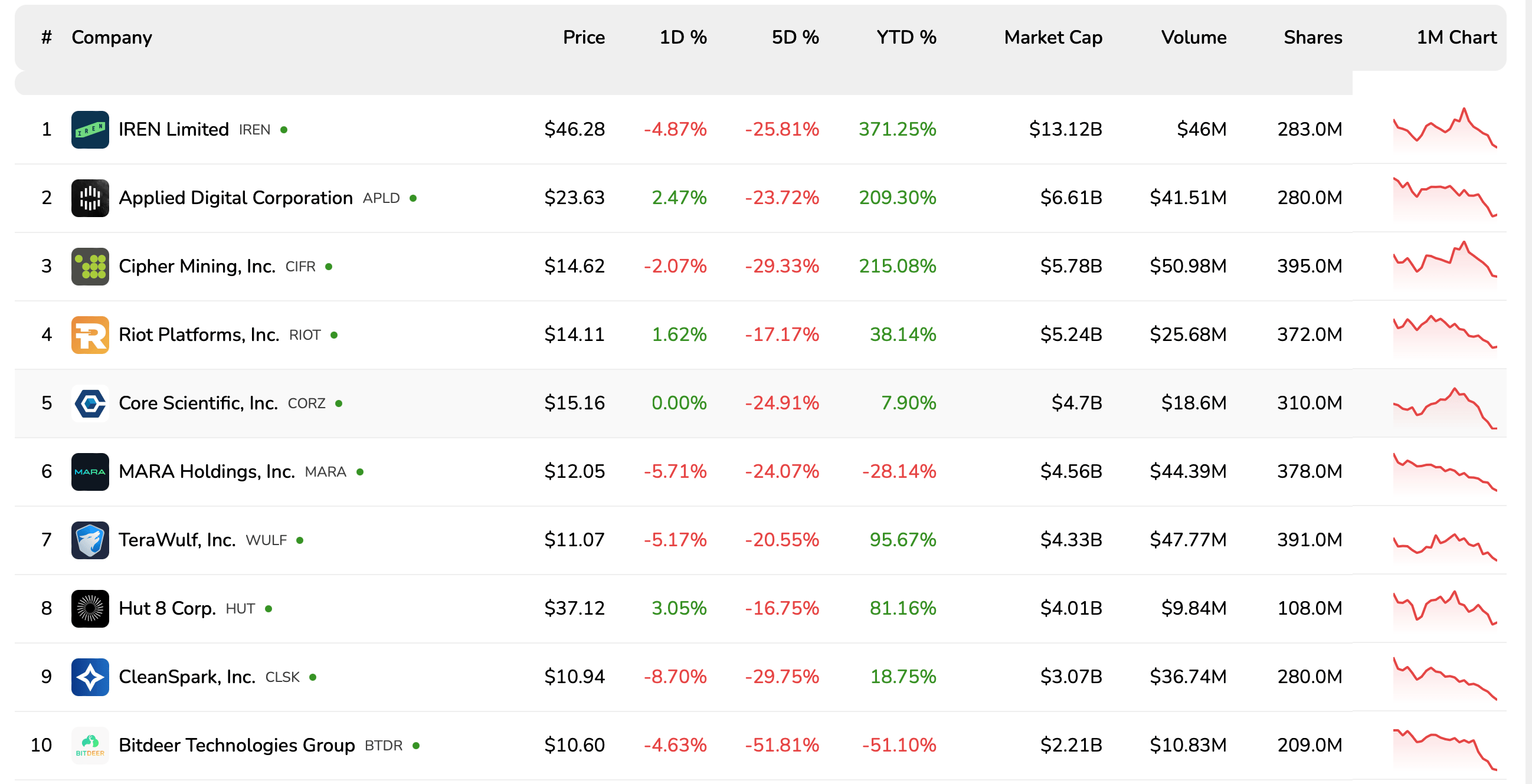Bitcoin mining stocks have declined sharply by 20% to 50% this week, underperforming Bitcoin’s 9% drop, as the sector loses over $20 billion in market value amid rising operational challenges and diversification to AI and high-performance computing.
-
Major miners like Cipher Mining and Core Scientific fell 23% to 52% over five days, far outpacing Bitcoin’s pullback.
-
Public mining companies have shed about 25% since mid-October, erasing billions despite institutional investments from firms like Jane Street and Fidelity.
-
Some miners, such as IREN and Cipher, boast 370% and 210% year-to-date gains, respectively, highlighting resilience through AI and HPC pivots, per TradingView data.
Discover why Bitcoin mining stocks are plunging 20-50% despite Bitcoin at $94,400. Explore diversification into AI/HPC and key takeaways for investors. Stay informed on crypto’s evolving landscape—read more now.
What is causing the recent decline in Bitcoin mining stocks?
Bitcoin mining stocks are experiencing a significant downturn due to intensified sector pressures, including halved block rewards and high energy costs, leading to double-digit losses for major players. Over the past week, companies like Cipher Mining and Applied Digital have seen drops of 23% to 52%, while Bitcoin itself only fell about 9% to around $94,400. This underperformance stems from broader market corrections and the mining industry’s lag, as reported by industry analysts.

Source: Bitcoin Mining Stocks
How are Bitcoin miners adapting through AI and high-performance computing?
Major Bitcoin miners are increasingly turning to artificial intelligence (AI) and high-performance computing (HPC) to offset declining mining profitability. With infrastructure already geared for high energy use and advanced cooling, firms are repurposing facilities for more stable revenue streams. For instance, a recent Miner Mag report indicated that public mining stocks have lost over $20 billion in value in the past month, a 25% drop since mid-October, exacerbating the need for diversification. Bitfarms announced plans to phase out Bitcoin mining over two years, closing its 18-megawatt Washington site to convert it into AI and HPC data centers, causing its stock to plummet. In contrast, Core Scientific secured a $3.5 billion deal with CoreWeave in June to host 200 megawatts for HPC, blending mining with new tech. CleanSpark’s shares rose 13% in October following its AI entry, and IREN inked a $9.7 billion, five-year agreement with Microsoft in early November for Nvidia GPU access. Experts like those from Fidelity note that institutional interest persists, with increased positions in miners despite short-term volatility. This shift could stabilize the sector, as AI workloads offer higher margins than intermittent Bitcoin rewards post-halving. Data from TradingView shows year-to-date outperformers like IREN up 370% and Cipher Mining up 210%, compared to Bitcoin’s modest 1.5% gain, underscoring the potential of hybrid models. However, challenges remain, including regulatory hurdles for AI integration and competition from non-mining data center operators.
Frequently Asked Questions
Why have Bitcoin mining stocks underperformed Bitcoin this week?
Bitcoin mining stocks dropped 20% to 50% due to sector-specific issues like rising costs and reduced rewards from halvings, while Bitcoin only fell 9%. Companies such as Riot and Hut 8 saw mid-teens losses, and the broader industry lost $20 billion in market value, per Miner Mag, amid a market pullback.
What opportunities exist for Bitcoin miners in AI and HPC sectors?
Bitcoin miners can leverage their energy-efficient data centers for AI and HPC tasks, providing steady income unlike volatile mining rewards. Deals like Core Scientific’s $3.5 billion agreement with CoreWeave demonstrate how hosting GPU workloads for clients such as Microsoft can drive long-term growth and outperform traditional mining.
Key Takeaways
- Sector Volatility: Bitcoin mining stocks erased billions this week, dropping 20-50% versus Bitcoin’s milder 9% decline, highlighting operational risks in a maturing crypto market.
- Diversification Wins: Miners pivoting to AI/HPC, like IREN’s Microsoft deal, show year-to-date gains up to 370%, offering a blueprint for sustainability.
- Institutional Support: Despite losses, firms like Jane Street and Barclays are boosting stakes, signaling confidence in miners’ evolving role beyond pure Bitcoin extraction.
Conclusion
The sharp decline in Bitcoin mining stocks underscores the challenges of relying solely on cryptocurrency extraction amid halvings and market swings, yet the pivot to AI and high-performance computing presents a promising path forward. With institutional backing and landmark deals reshaping the landscape, the sector is poised for resilience. Investors should monitor these hybrid strategies closely, as they could redefine profitability in the coming years—consider exploring diversified crypto portfolios for long-term stability.
